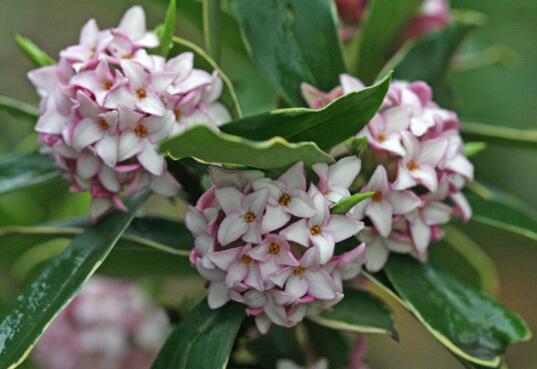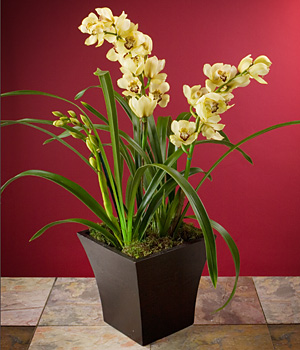Prevention and control of diseases and insect pests of Daphne odora
Main diseases
Control of stem rot
Phnom Penh Daphne is a precious flower flower loved by the masses, but it is difficult to keep it delicate. The main reason is stem rot.
Symptoms: the disease is not easy to be detected at the initial stage. The first manifestation of the disease is the rhizome. The phloem of the disease blackened and rotted, and gradually developed to the root. However, the performance of the parenchyma was normal, the leaves were green and did not fall until death, and no symptoms were found on the surface.
2. The characteristics of the disease: the onset period of the disease is from June to October, and the peak is from July to September. It is a period of high temperature and strong light. It was observed that the incidence rate was 37.5% when placed in sunny places throughout the day, while only 5% occurred when the sun was hidden from 9: 00:00 to 4: 00:00 p.m.
The diseased plants are mainly 1-5-year-old plants with rapid growth in spring and numerous leaves, and have strong infectivity.
In terms of cultivated soil, the incidence of easy drying of basin soil was significantly higher than that of good water retention. The incidence of decayed leaf soil with 80% and 20% river sand was significantly lower than that of rotten leaf soil with half and half river sand content. The incidence of fire dung soil with 100% soil is lower than that with high sand content.
Prevention and control methods: according to the incidence characteristics of Phnom Penh Daphne and three years of practice, the prevention and control of stem rot can start from five aspects:
1. The selection of cultivated soil: choose the soil rich in humus with good drainage and water retention. This kind of soil can dig the surface rotten leaf soil directly from the mountain forest region and mix it with a small amount of river sand and mature cake fertilizer, or choose vegetable garden soil to add part of rotten leaf soil, a small amount of river sand and rotten cake fertilizer.
2. The choice of environment for placing potted flowers: Phnom Penh Daphne is a kind of plant that likes cool and ventilated environment. From June to October, potted flowers should be placed in a cool place from 9 a.m. to 4 p.m. Or take the method of setting up a shed to solve the problem.

If we want to know what to do with the long worm of Daphne odora in Phnom Penh, we first need to know what kind of insect is growing, so that we can deal with it pertinently, because the treatment methods of each kind of diseases and insect pests are different. Details are introduced below, interested friends can learn about it.
II. Pest control of Phnom Penh Daphne odora (pest)
Aphids
Aphids are one of the most destructive pests on earth, which are harmful to many plants, and Phnom Penh Daphne is no exception. It mainly feeds on the sap of the plant, which leads to the loss of a large amount of nutrients, and finally gradually withered and died.
Control methods: for aphids, the diseases and insect pests of Phnom Penh Daphne, we can use 40% imidacloprid water solvent 1500 to 2000 times to spray it, generally 2-3 times in a row can be eliminated.
Shell worm
The scale insect is a kind of pest that occurs in the growth process of many plants, and Phnom Penh Daphne is no exception. This pest mainly feeds on the sap in the leaves and stems of Phnom Penh. It will gradually absorb the juice, resulting in the gradual loss of nutrients in Phnom Penh, and finally shrinking.
Control method: when dealing with the disease and insect pest of Phnom Penh Daphne, we can use 2000 times of omethoate to spray, usually three times in a row can completely kill this pest.
III. Disease and pest control of Phnom Penh Daphne (disease)
Stem rot
Stem rot is a common disease in Phnom Penh. This disease mainly harms the roots of plants. When the disease occurs, the phloem of the roots will blacken and rot, and gradually develop to the roots, resulting in the decay and death of the whole plant.
Control method: when we deal with this disease and insect pest of Phnom Penh, we can use 38% cuproloxil 1000 times solution to irrigate the root, usually once every 5-7 days, and then recover after 3-4 times.
Fusarium wilt
Fusarium wilt is a disease caused by fungi, the pathogen generally invades from the root wound, and gradually spreads with the passage of the event, generally from morbidity to death, the course of disease is generally 15-45 days, is a very harmful disease.
Prevention and control methods: when we aim at the diseases and insect pests of Phnom Penh, we can use carbendazim or benzoate 800-1000 times to irrigate the roots of Phnom Penh, usually once a week, 5-6 times later can be cured.
Leaf spot disease
Leaf spot is a disease that may occur in many plants, and Phnom Penh Daphne is no exception. Small green dots will appear on the leaves at the time of the disease, and in the later stage, they will expand into larger disease spots that are nearly round, and in severe cases, the leaves will fall off completely and grow weaker until the whole plant dies.
Control methods: when dealing with the diseases and insect pests of Phnom Penh Daphne, we can use 500-800 times of methyl topiramate to spray the diseased plants, usually once every 7-10 days, 2-3 times can be cured.
Control methods of diseases and insect pests of Daphne odora in Phnom Penh
The main diseases of Phnom Penh are stem rot, root rot and mosaic disease, and the main insect pests are aphids and shell insects. The prevention and control should adhere to the principle of "prevention and comprehensive control".
(1) strengthen the management of flower beds.
1. Strictly control the flow of diseased seedlings and propagate seedlings with diseased branches.
two。 Rational fertilization, scientific watering, nitrogen fertilizer should not be overweight, appropriate application of phosphorus and potassium fertilizer to enhance plant disease resistance.
3. To do a good job in the hygiene of the flower bed, the diseased plants, litter and weeds in the flower bed should be removed in time to eliminate the source of pathogens.
(2) chemical control.
1. Stem rot. The root neck is mainly damaged, the root neck becomes yellowish brown and rotten, and the plant wilts and dies. Choose 50% carbendazim 500 times solution or 40% carbendazim wettable powder 800 times solution, alternately spray 4-5 times, can be better prevention and control.
two。 Root rot. It is mainly caused by excessive wet waterlogging or excessive concentrated fertilization in the basin soil, which burns the root system. 1000-fold solution of 30% pinggangmycin powder or 500-fold solution of Gen Funing is selected and sprayed alternately for 4-5 times, which can be well prevented.
3. Mosaic disease. Spray with 10% virus king 600 times and control aphids at the same time.
4. Pests. Insect pests can occur all the year round, mainly with 40% omethoate emulsion 1000 times or 40% isocarbophos emulsion 1000 times and so on.
- Prev

What are the common diseases and insect pests of cyclamen? How to prevent?
Cyclamen is very susceptible to disease and should be planted in a clean, well-drained place. The main diseases were fusarium oxysporum, wilting disease, soft root disease, gray mold, wilt disease and spider. 1. Fusarium oxysporum disease. The pathogen often lurks in the seedlings until the disease begins after the seedlings are transplanted
- Next

Control of Diseases and insect pests of Cymbidium
Fungal anthracnose mostly occurs at the top of the leaf, the edge of the spot is dark brown, the middle is gray, mostly caused by high temperature, high humidity, poor ventilation, the spot should be cut off in time, and cooperate with spraying. Common medicament has 1000 times mancozeb and 1000 times mancozeb.
Related
- Fuxing push coffee new agricultural production and marketing class: lack of small-scale processing plants
- Jujube rice field leisure farm deep ploughing Yilan for five years to create a space for organic food and play
- Nongyu Farm-A trial of organic papaya for brave women with advanced technology
- Four points for attention in the prevention and control of diseases and insect pests of edible fungi
- How to add nutrient solution to Edible Fungi
- Is there any good way to control edible fungus mites?
- Open Inoculation Technology of Edible Fungi
- Is there any clever way to use fertilizer for edible fungus in winter?
- What agents are used to kill the pathogens of edible fungi in the mushroom shed?
- Rapid drying of Edible Fungi

